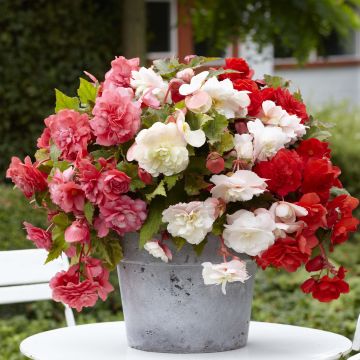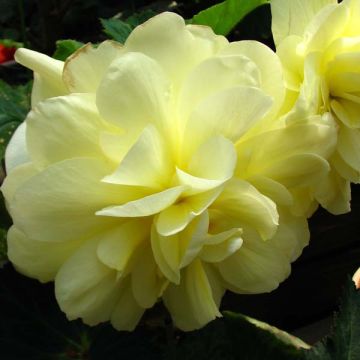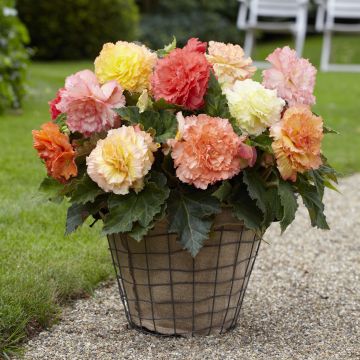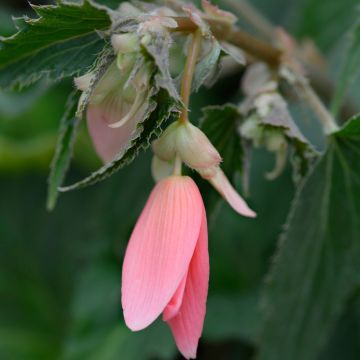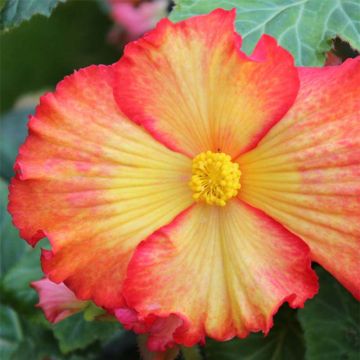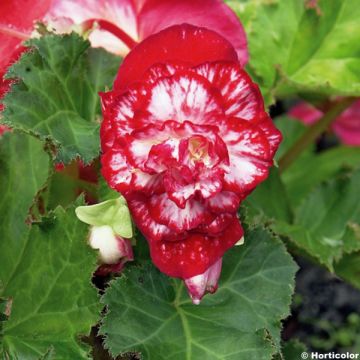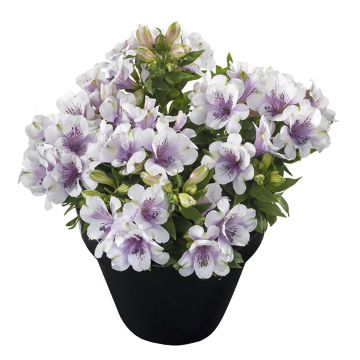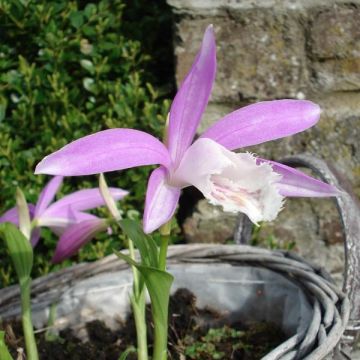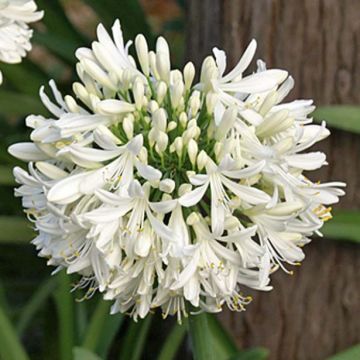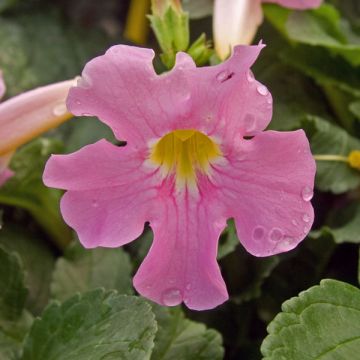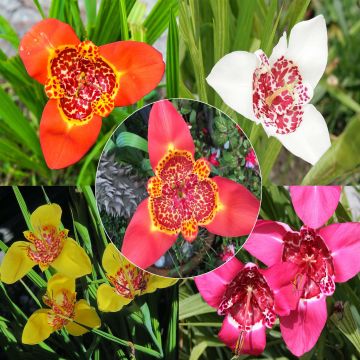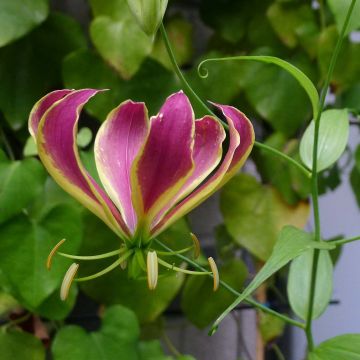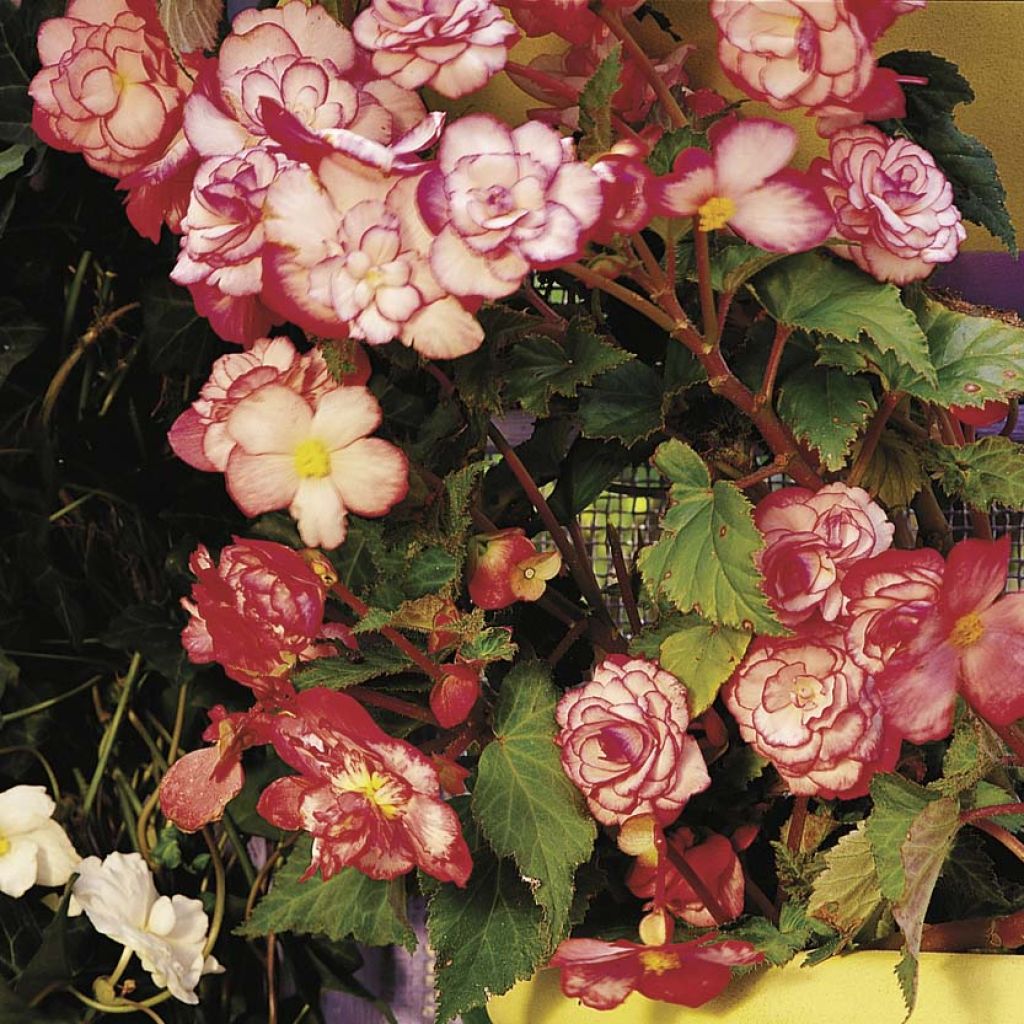

Begonia erecta Bouton de Rose - Begonia bulbs
Begonia erecta Bouton de Rose - Begonia bulbs
Begonia erecta Bouton de Rose
Begonia
This item cannot be shipped to the selected country
Delivery charge from €5.90
More information
Schedule delivery date,
and select date in basket
This plant carries a 6 months recovery warranty
More information
We guarantee the quality of our plants for a full growing cycle, and will replace at our expense any plant that fails to recover under normal climatic and planting conditions.
From €5.90 for pickup delivery and €6.90 for home delivery
Express home delivery from €8.90.
Does this plant fit my garden?
Set up your Plantfit profile →
Description
Begonia erecta 'Bouton de Rose' boasts very large, well-double and plump corollas. Finely edged in dark pink on a pale pink background illuminated with white, the flowers are highlighted by a beautiful, shiny, deeply cut foliage with olive green reflections. This variety with an upright habit and dense growth is a gem for partial shade, both in the ground and in pots.
The 'Bouton de Rose' Begonia belongs to the begonia family. It is part of the tuberous begonia hybrids, whose parents mainly originate from Andean tropical forests. It is a cultivar that combines the characteristics of the 'Picotee' groups, flowering tirelessly from July to October. It will reach a maturity of about 40cm (16in) in all directions. From spring onwards, it shows a compact tufted or large cushion habit. Its foliage is deciduous, medium green tinged with olive and bronze, shiny, alternate, and the edges are deeply cut. The blades are always asymmetrical and fleshy in texture; the petioles have stipules at their base. The stems of this begonia are thick and relatively sturdy. Its very large 10cm (4in) diameter flowers at a minimum are globular and perfectly formed, composed of pleated petals like crepe paper, pale pink, whiter in the centre, with a fine border of almost red. The centre of the flower is occupied by a group of tightly packed small petals forming a flower bud. After flowering, which extends from June to October without interruption, the plant goes into dormancy. The tubers will be cultivated like those of Dahlias, meaning they will be stored in a dry, frost-free place in the shade during winter.
Begonias are unmatched in bringing colour to shaded areas. They are also comfortable in well-tended flower beds, in the company of lighter flowers such as lobelias or forget-me-nots, as well as when grown in pots on the terrace or in hanging baskets. This superb variety will be perfectly showcased in large pots in the conservatory or in the veranda. Finally, it is good to know that there are hardy begonias, such as Begonia grandis.
Report an error about the product description
Begonia erecta Bouton de Rose - Begonia bulbs in pictures
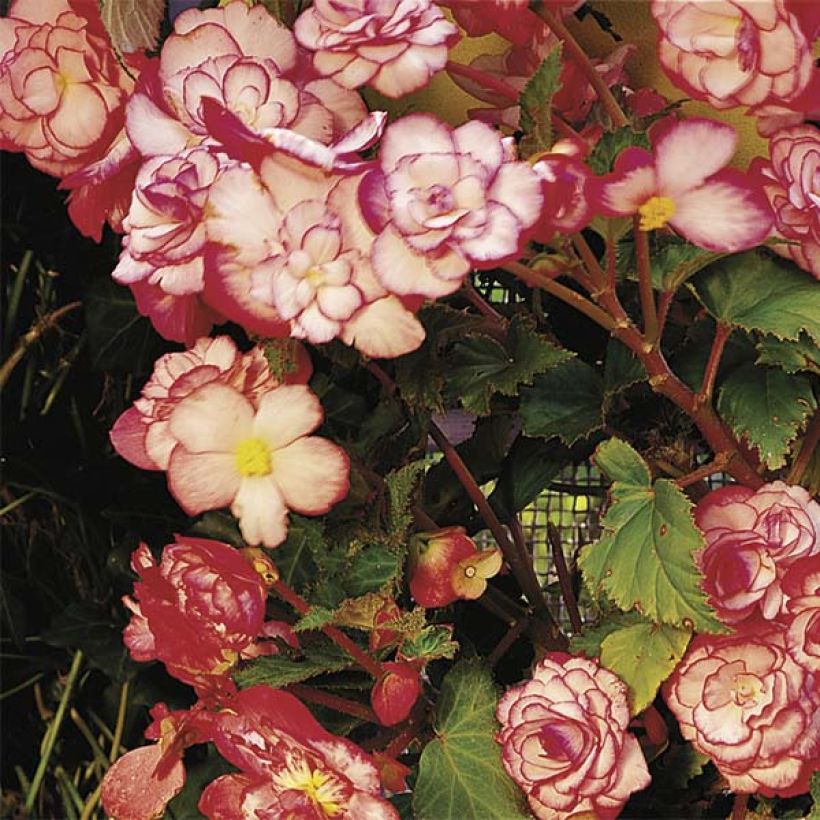

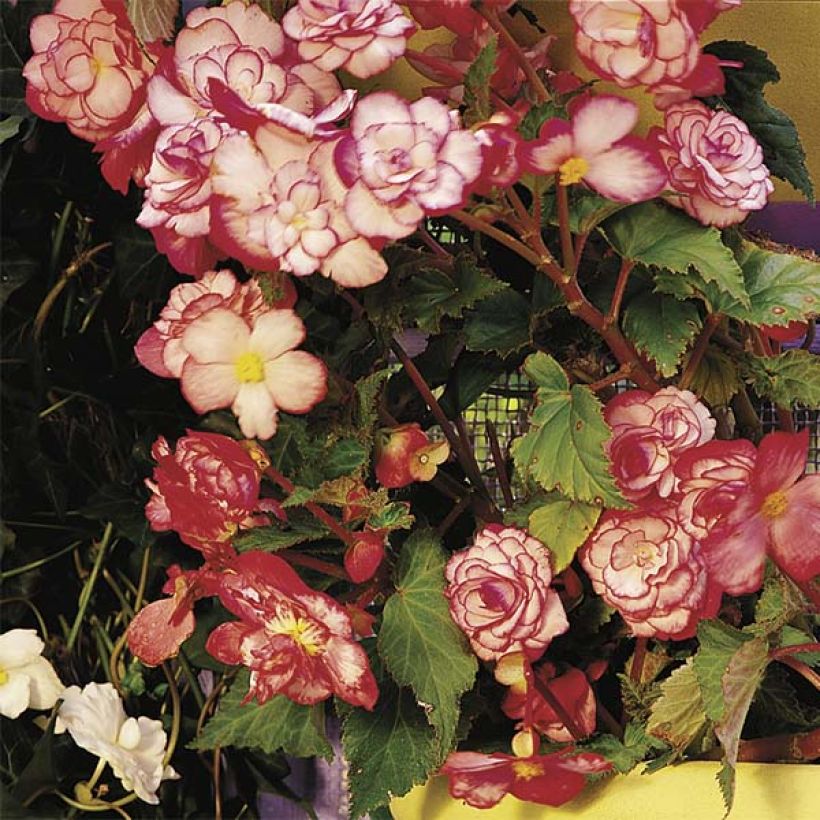

Plant habit
Flowering
Foliage
Botanical data
Begonia
erecta
Bouton de Rose
Begoniaceae
Begonia
Cultivar or hybrid
Other Begonias
Planting and care
Place your begonias in a shady or slightly sunny location, in a light and moist soil rich in humus. Begonias dislike heavy soils, so lighten it if necessary with some sand. Plant after the last frost, one per pot of about twenty cm, or spaced 25cm (10in) apart in open ground. Place the hollow side of the begonia upwards, and cover with 5cm (2in) of soil. Like Dahlias, you can speed up their growth cycle by planting them as early as February, in a pot, kept sheltered, and taking them out in May. Water regularly. Apply a begonia fertilizer when planting, and then twice a month during the season. Remove faded flowers. Dig up the bulbs before the first frost, and store them in a little turf, in a dry and cool place, during the winter.
Tip: to obtain larger flowers in camellia or rose-flowered cultivars, you can remove the buds of the small female flowers located on either side of the large and very double male flower.
Planting period
Intended location
Care
-
, onOrder confirmed
Reply from on Promesse de fleurs
Bulbs to grow in pots
Haven't found what you were looking for?
Hardiness is the lowest winter temperature a plant can endure without suffering serious damage or even dying. However, hardiness is affected by location (a sheltered area, such as a patio), protection (winter cover) and soil type (hardiness is improved by well-drained soil).

Photo Sharing Terms & Conditions
In order to encourage gardeners to interact and share their experiences, Promesse de fleurs offers various media enabling content to be uploaded onto its Site - in particular via the ‘Photo sharing’ module.
The User agrees to refrain from:
- Posting any content that is illegal, prejudicial, insulting, racist, inciteful to hatred, revisionist, contrary to public decency, that infringes on privacy or on the privacy rights of third parties, in particular the publicity rights of persons and goods, intellectual property rights, or the right to privacy.
- Submitting content on behalf of a third party;
- Impersonate the identity of a third party and/or publish any personal information about a third party;
In general, the User undertakes to refrain from any unethical behaviour.
All Content (in particular text, comments, files, images, photos, videos, creative works, etc.), which may be subject to property or intellectual property rights, image or other private rights, shall remain the property of the User, subject to the limited rights granted by the terms of the licence granted by Promesse de fleurs as stated below. Users are at liberty to publish or not to publish such Content on the Site, notably via the ‘Photo Sharing’ facility, and accept that this Content shall be made public and freely accessible, notably on the Internet.
Users further acknowledge, undertake to have ,and guarantee that they hold all necessary rights and permissions to publish such material on the Site, in particular with regard to the legislation in force pertaining to any privacy, property, intellectual property, image, or contractual rights, or rights of any other nature. By publishing such Content on the Site, Users acknowledge accepting full liability as publishers of the Content within the meaning of the law, and grant Promesse de fleurs, free of charge, an inclusive, worldwide licence for the said Content for the entire duration of its publication, including all reproduction, representation, up/downloading, displaying, performing, transmission, and storage rights.
Users also grant permission for their name to be linked to the Content and accept that this link may not always be made available.
By engaging in posting material, Users consent to their Content becoming automatically accessible on the Internet, in particular on other sites and/or blogs and/or web pages of the Promesse de fleurs site, including in particular social pages and the Promesse de fleurs catalogue.
Users may secure the removal of entrusted content free of charge by issuing a simple request via our contact form.
The flowering period indicated on our website applies to countries and regions located in USDA zone 8 (France, the United Kingdom, Ireland, the Netherlands, etc.)
It will vary according to where you live:
- In zones 9 to 10 (Italy, Spain, Greece, etc.), flowering will occur about 2 to 4 weeks earlier.
- In zones 6 to 7 (Germany, Poland, Slovenia, and lower mountainous regions), flowering will be delayed by 2 to 3 weeks.
- In zone 5 (Central Europe, Scandinavia), blooming will be delayed by 3 to 5 weeks.
In temperate climates, pruning of spring-flowering shrubs (forsythia, spireas, etc.) should be done just after flowering.
Pruning of summer-flowering shrubs (Indian Lilac, Perovskia, etc.) can be done in winter or spring.
In cold regions as well as with frost-sensitive plants, avoid pruning too early when severe frosts may still occur.
The planting period indicated on our website applies to countries and regions located in USDA zone 8 (France, United Kingdom, Ireland, Netherlands).
It will vary according to where you live:
- In Mediterranean zones (Marseille, Madrid, Milan, etc.), autumn and winter are the best planting periods.
- In continental zones (Strasbourg, Munich, Vienna, etc.), delay planting by 2 to 3 weeks in spring and bring it forward by 2 to 4 weeks in autumn.
- In mountainous regions (the Alps, Pyrenees, Carpathians, etc.), it is best to plant in late spring (May-June) or late summer (August-September).
The harvesting period indicated on our website applies to countries and regions in USDA zone 8 (France, England, Ireland, the Netherlands).
In colder areas (Scandinavia, Poland, Austria...) fruit and vegetable harvests are likely to be delayed by 3-4 weeks.
In warmer areas (Italy, Spain, Greece, etc.), harvesting will probably take place earlier, depending on weather conditions.
The sowing periods indicated on our website apply to countries and regions within USDA Zone 8 (France, UK, Ireland, Netherlands).
In colder areas (Scandinavia, Poland, Austria...), delay any outdoor sowing by 3-4 weeks, or sow under glass.
In warmer climes (Italy, Spain, Greece, etc.), bring outdoor sowing forward by a few weeks.

































